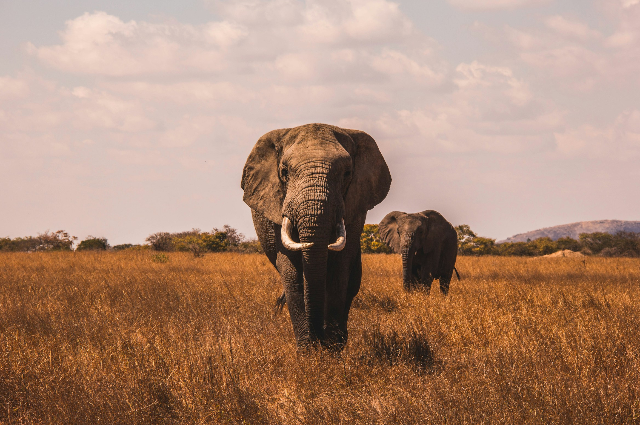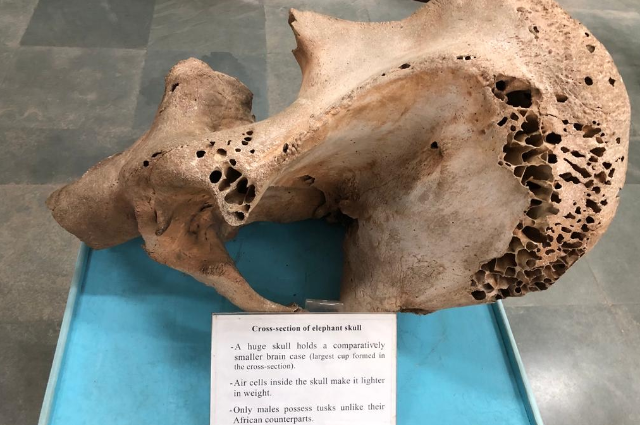
Elephants are magnificent wild animals known for their large size, long trunks, and remarkable intelligence. They inhabit various regions across Africa and Asia and play crucial roles in their ecosystems. These gentle giants are herbivores, consuming vast amounts of vegetation daily. Unfortunately, they face threats like habitat loss and poaching, making conservation efforts vital to protect these iconic creatures. Elephants are remarkable creatures with unique anatomy and morphology adapted for their large size and specific ecological roles. Here are some key aspects of their anatomy and morphology:
- Size: Elephants are the largest land animals on Earth. They can weigh up to several tons and stand up to 13 feet (4 meters) tall at the shoulder.
- Trunk: The most distinctive feature of an elephant is its trunk. This elongated, muscular appendage is a fusion of the nose and upper lip. It's incredibly versatile and serves various functions, including breathing, drinking, grasping objects, and even making sounds.
- Tusks: Both African and Asian elephants can have tusks, which are elongated, curved teeth. Tusks are used for various tasks, such as digging, foraging, defence, and in some cases, as weapons. Unfortunately, tusks have also made elephants targets for ivory poaching.
- Ears: Elephants have large ears that help regulate their body temperature. Blood vessels in their ears radiate heat, acting as natural cooling systems. The shape of their ears can vary between African and Asian elephants.
- Teeth: Elephants have a unique set of teeth, with six sets of molars throughout their lives. These molars are continuously replaced as they wear down. Grinding of plant material with these teeth is essential for their herbivorous diet.
- Legs and Feet: Their legs are sturdy and pillar-like to support their massive bodies. Elephants have relatively short, thick legs with padded feet, which help them move through various terrains, including soft mud.
- Skin: Elephant skin is thick, rough, and wrinkled, which helps to retain moisture and protect them from the sun. It can also be quite sensitive to touch.
- Tail: Elephants have a relatively long, coarse tail with a tuft of hair at the end. They use their tails to swat away insects and communicate with other elephants.
- Molting: Elephants undergo molting, where patches of old skin peel away in sheets. This process helps them get rid of parasites and dead skin.
- Digestive System: Elephants have a specialized digestive system to process the high-fiber, low-nutrient vegetation they consume. They rely on fermentation in their large, complex stomachs to break down cellulose.
- Brain: Elephants have large brains, known for their high intelligence and complex social behaviours. They exhibit problem-solving skills, self-awareness, and strong social bonds within their herds.
- Tongue: The tongue of an elephant is muscular and can be used for various tasks, such as grasping and manipulating food.
Elephants are not only fascinating in terms of their anatomy and morphology but also for their ecological importance and their role in shaping the ecosystems they inhabit. Their unique adaptations have allowed them to thrive in diverse habitats across Africa and Asia. Elephants hold significant importance in the wild for several reasons. Elephants play a crucial role in shaping their habitats as ecosystem engineers. They create water holes by digging in dry riverbeds, which benefit other animals during droughts. Their feeding habits also influence plant diversity. They consume a wide variety of plants and fruits, and their dung serves as a means of seed dispersal, helping maintain plant diversity in their ecosystems. By feeding on different types of vegetation through browsing and grazing, elephants can influence the composition and structure of vegetation, which can benefit other herbivores and maintain a balanced ecosystem. Elephants are charismatic megafauna, attracting tourists to wildlife reserves and providing income for local communities through ecotourism, which supports conservation efforts. Hence they have significant cultural and ecotourism values.
The health of elephant populations can serve as an indicator of the overall health of an ecosystem. Declining elephant numbers often signal broader ecosystem issues. Maintaining healthy elephant populations helps preserve genetic diversity, which is vital for the long-term survival of the species. Studying elephants in the wild provides valuable insights into animal behaviour, communication, and social structures, contributing to our understanding of wildlife. Conserving elephants is not just about protecting a single species; it's about preserving the intricate web of life in their ecosystems and the cultural and economic benefits they provide to local communities and the world.

Conserving elephants requires a combination of local and international efforts. Here are some key strategies for elephant conservation Anti-Poaching Measures: Implement rigorous anti-poaching initiatives to combat the illegal ivory trade and poaching of elephants. This includes increased law enforcement, technology like drones, and community engagement to report poaching activities.
- Habitat Protection: Preserve and protect elephant habitats by creating and maintaining wildlife reserves and national parks. Ensure these areas are well-managed to minimize human encroachment.
- Community Involvement: Engage local communities in conservation efforts. Providing incentives for communities to protect elephants and their habitats can reduce human-elephant conflicts and promote coexistence.
- Corridor Creation: Establish and maintain wildlife corridors that allow elephants to migrate and maintain genetic diversity, even in fragmented landscapes.
- Research and Monitoring: Continuously study elephant populations and behaviours to inform conservation strategies. Monitoring helps identify threats and assess the effectiveness of conservation programs.
- Reducing Demand: Combat the demand for ivory and other elephant products through public awareness campaigns, stricter regulations on ivory trade, and international cooperation to stop illegal trafficking.
- Human-Elephant Conflict Mitigation: Develop and implement strategies to reduce conflicts between elephants and local communities, such as using barriers, early warning systems, and non-lethal deterrents.
- Transboundary Cooperation: Collaborate with neighbouring countries to protect elephant populations that cross borders. Migration routes often extend beyond national boundaries.
- Education and Advocacy: Raise awareness about the importance of elephant conservation and the ecological roles they play. Advocate for policy changes and support organizations dedicated to elephant protection.
- Tourism Management: Regulate wildlife tourism to ensure it doesn't disrupt elephant behaviour or habitats. Ecotourism can provide funding for conservation efforts when managed sustainably.
- Climate Change Mitigation: Address climate change, which can impact elephant habitats and food sources. Reducing greenhouse gas emissions can indirectly benefit elephant conservation.
Conserving elephants is a complex task that requires the cooperation of governments, NGOs, local communities, and the international community. It's essential to address the underlying causes of their decline, including habitat loss and demand for ivory, while also protecting their natural habitats, and environments and promoting coexistence with human communities.
